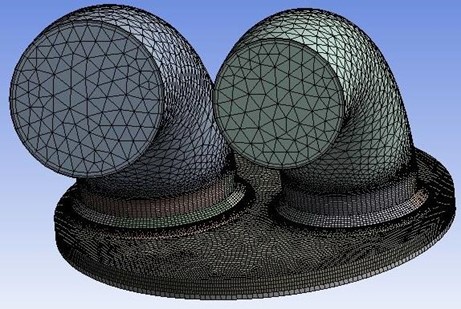Modeling of charge admission in a sequential methodology for HCCI combustion
DOI:
https://doi.org/10.33131/24222208.379Keywords:
CFD, chemical kinetics, HCCI, internal combustion engine, numerical simulationAbstract
Using waste or biomass for electricity production has been proposed as an energy and environmental alternative in urban and rural areas. At generation scales under 75 kW, employing internal combustion engines in advanced combustion modes of operation allows for addressing technical and efficiency challenges encountered when using gaseous fuels of renewable origin in conventional technologies. Numerical simulation techniques optimize the performance of these recent technologies and allow the addressing and understanding of the complex phenomena inside the cylinder. This study presents the use of a sequential numerical methodology, CFD - detailed chemical kinetics, to analyze the thermal and mass distribution of the air/fuel mixture before ignition and development of combustion in a modified diesel engine operating with biogas at 1800 RPM. It can be seen how the flow patterns lead to a build-up of the charge in the higher temperature zones and thus produce short combustion durations even for delayed conditions. conditions.
Downloads
References
J. Rodríguez, J. Tobón, M. Frías, y M. I. Sánchez de Rojas, «Aprovechamiento de un residuo del carbón para reducción del impacto ambiental de la minería del carbón en Colombia: estudio del potencial de uso en la industria del cemento», Rev. CINTEX, vol. 23, n.o 2, pp. 95-102, dic. 2018, doi: 10.33131/24222208.323.
F. Møller, E. Slentø, y P. Frederiksen, «Integrated well-to-wheel assessment of biofuels combining energy and emission LCA and welfare economic Cost Benefit Analysis», Biomass Bioenergy, vol. 60, pp. 41-49, ene. 2014, doi: 10.1016/j.biombioe.2013.11.001.
S. Heredia Quintana y A. D. Morales-Rojas, «Desarrollo y validación de un modelo cero dimensional de dos zonas para el análisis de la combustión en motores de encendido provocado», Rev. CINTEX, vol. 23, n.o 2, pp. 25-33, dic. 2018, doi: 10.33131/24222208.321.
A. Alagumalai, «Internal combustion engines: Progress and prospects», Renew. Sustain. Energy Rev., vol. 38, pp. 561-571, oct. 2014, doi: 10.1016/j.rser.2014.06.014.
E. Porpatham, A. Ramesh, y B. Nagalingam, «Effect of compression ratio on the performance and combustion of a biogas fuelled spark ignition engine», Fuel, vol. 95, pp. 247-256, may 2012, doi: 10.1016/j.fuel.2011.10.059.
M. Gómez, A. Amell, y L. Zapata, «Spark ignition engine performance and emissions in a high compression engine using biogas and methane mixtures without knock occurrence», Therm. Sci., vol. 19, n.o 6, pp. 1919-1930, 2015, doi: 10.2298/TSCI140829119G.
M. M. Hasan y M. M. Rahman, «Homogeneous charge compression ignition combustion: Advantages over compression ignition combustion, challenges and solutions», Renew. Sustain. Energy Rev., vol. 57, pp. 282-291, may 2016, doi: 10.1016/j.rser.2015.12.157.
J. E. Dec, «Advanced compression-ignition engines—understanding the in-cylinder processes», Proc. Combust. Inst., vol. 32, n.o 2, pp. 2727-2742, 2009, doi: 10.1016/j.proci.2008.08.008.
M. Yao, Z. Zheng, y H. Liu, «Progress and recent trends in homogeneous charge compression ignition (HCCI) engines», Prog. Energy Combust. Sci., vol. 35, n.o 5, pp. 398-437, oct. 2009, doi: 10.1016/j.pecs.2009.05.001.
S. M. Aceves et al., «A Multi-Zone Model for Prediction of HCCI Combustion and Emissions», presentado en SAE 2000 World Congress, mar. 2000, pp. 2000-01-0327. doi: 10.4271/2000-01-0327.
A. Babajimopoulos, D. N. Assanis, D. L. Flowers, S. M. Aceves, y R. P. Hessel, «A fully coupled computational fluid dynamics and multi-zone model with detailed chemical kinetics for the simulation of premixed charge compression ignition engines», Int. J. Engine Res., vol. 6, n.o 5, pp. 497-512, oct. 2005, doi: 10.1243/146808705X30503.
I. D. Bedoya, F. Cadavid, S. Saxena, R. Dibble, S. Aceves, y D. Flowers, «A Sequential Chemical Kinetics-CFD-Chemical Kinetics Methodology to Predict HCCI Combustion and Main Emissions», presentado en SAE 2012 World Congress & Exhibition, abr. 2012, pp. 2012-01-1119. doi: 10.4271/2012-01-1119.
S. Heredia Quintana, «Desarrollo e implementación de una metodología secuencial CFD-cinética química detallada para el análisis de la combustión HCCI y sus principales emisiones en motores estacionarios», Master, Universidad de Antioquia, Medellín, Colombia, 2020. [En línea]. Disponible en: https://bibliotecadigital.udea.edu.co/handle/10495/15326
J. Kubesh, S. R. King, y W. E. Liss, «Effect of Gas Composition on Octane Number of Natural Gas Fuels», presentado en International Fuels & Lubricants Meeting & Exposition, oct. 1992, p. 922359. doi: 10.4271/922359.
D. C. Montgomery, Design and analysis of experiments, Tenth edition. Hoboken, NJ: Wiley, 2020.
S. H. Quintana, E. S. Castaño-Mesa, y I. D. Bedoya, «Experimental Study of the Polytropic Coefficient for an Air-Cooled, High-Compression-Ratio, Spark-Ignition Engine Fueled with Natural Gas, Biogas, and a Propane–Syngas Blend», Energy Fuels, vol. 32, n.o 2, pp. 2376-2384, feb. 2018, doi: 10.1021/acs.energyfuels.7b03063.

Downloads
Published
How to Cite
Issue
Section











